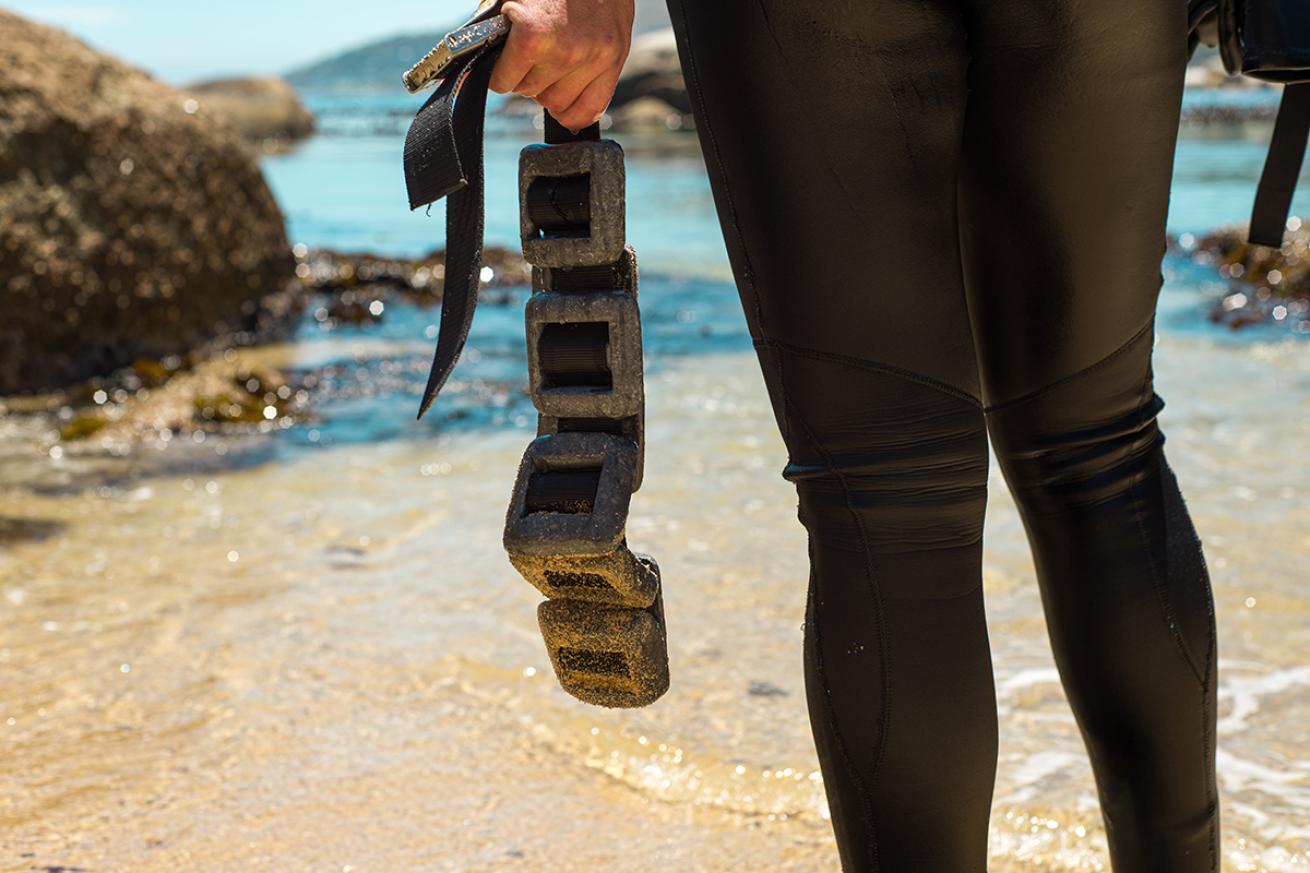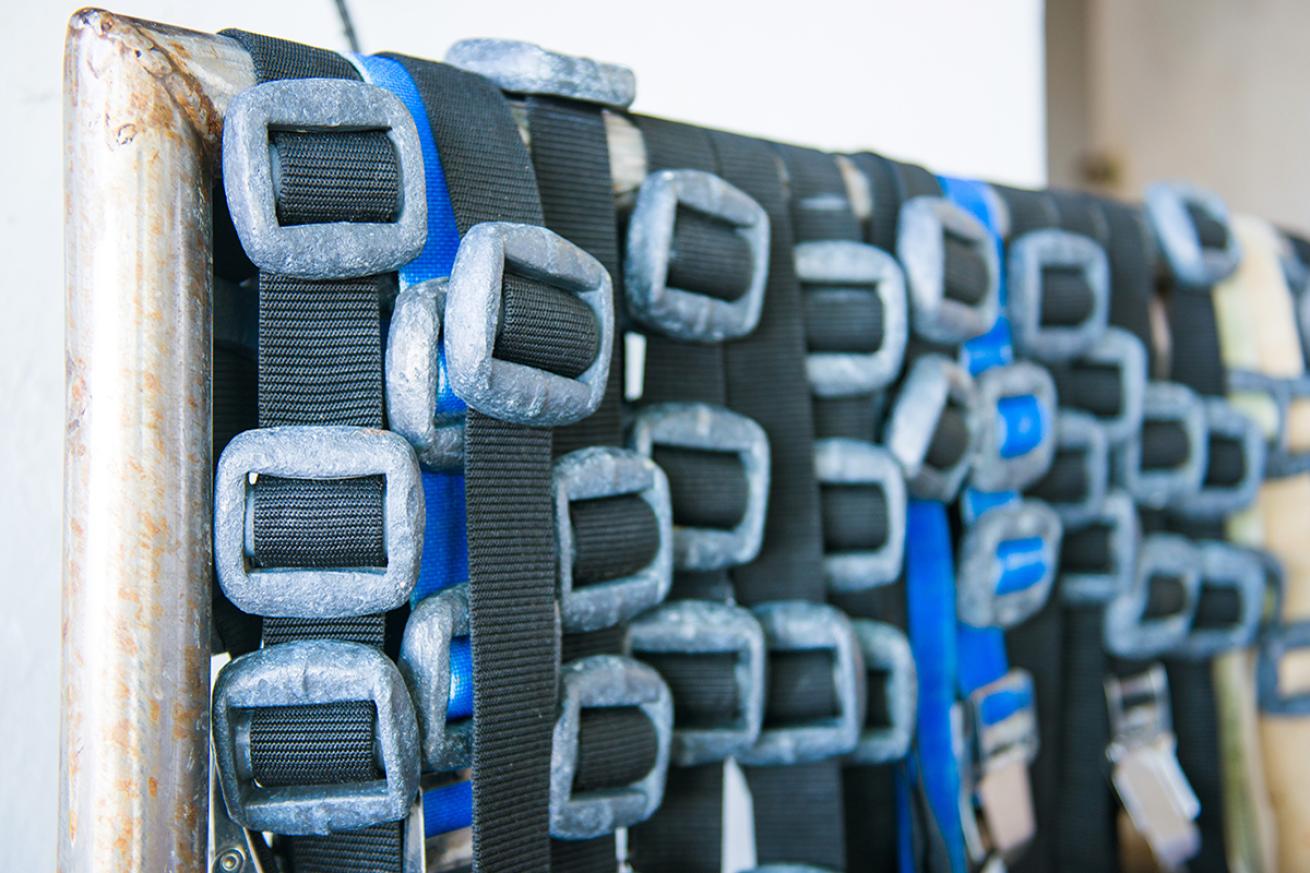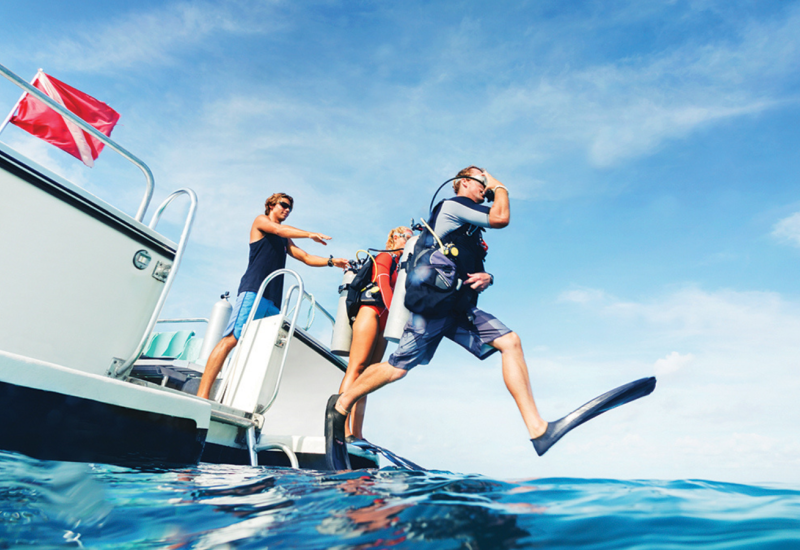Buoyancy Calculator—How Much You Need in Dive Weights

Pool Dive
Katy Danca Galli
“Any object, wholly or partially immersed in a fluid, is buoyed up by a force equal to the weight of the fluid displaced by the object." — Archimedes of Syracuse
It’s the bane of all divers. We want to go down, but the inherent buoyancy in our wetsuits, our BCs, our lungs and our fat cells are all conspiring to keep that from happening.
To overcome the force of buoyancy you have to counterbalance it with ballast weight. The question is, how much? While the answer is different for every diver, the goal is the same: carry enough weight to enable you to function efficiently and safely at all depths, and not an ounce more.
Divers are generally taught to define this as being neutrally buoyant at 15 feet deep while wearing an empty BC and carrying a nearly empty tank. But how do you get there? There’s the basic ballpark method — carry 10 percent of your body weight in lead. Or there’s the surface float method — in full scuba gear, load enough weight to enable you to float with the water at eye level (some would say at the hairline).
But rather than just blindly piling on the lead, why not break it down to find out why you need to carry the weight you do, and what specifically you are counterbalancing. By deconstructing your buoyancy status, you know exactly where your counterweight needs are greatest, and that might reveal ways to reduce the amount of weight you ultimately have to carry. Here’s how:
STEP 1: Calculate for Your Body
How much weight do you need to make your body neutral? Take a few weights into the water wearing just a swimsuit. You will be perfectly weighted when you can hang motionless with half a breath, and sink when you exhale. (Using a snorkel can make this test easier.)
Tip for Shaving Ballast Weight: Lose weight. Also, work to turn your fat to muscle. Fat mass is a lot more buoyant than muscle mass, so any fat you can convert to muscle will lower your buoyancy deficit.
STEP 2: Calculate for Your Exposure Suit
Wearing your exposure suit, get into the water and repeat the procedure outlined in Step 1. Then take the total amount of weight required to get neutral, subtract Step 1’s total, and you’ll have the net buoyancy budget for your exposure suit.
Tip for Shaving Ballast Weight: If water conditions permit, cut down on the thickness of your wetsuit. A wetsuit can have two to three pounds of buoyancy for every millimeter of thickness. If you wear a neoprene drysuit, consider that compressed or crushed neoprene suits have much less buoyancy than standard neoprene. If you wear a fabric drysuit, remember that thinner undergarments have much less buoyancy than the puffy stuff.
STEP 3: Calculate for Your BC
BCs can be a huge source of inherent buoyancy, especially the older, full-featured models that have lots of traditional-style padding. It used to be common for BCs to carry upwards of four pounds-plus of inherent buoyancy, which means, of course, that you need four pounds-plus of extra lead on your weight belt to compensate for it. Fortunately, most modern BCs carry much less inherent buoyancy.
To test your BC’s inherent buoyancy, submerge it while venting all exhaust valves to bleed air from the bladder. Knead the padding in the shoulders and backpad and behind the pockets to release air bubbles. Slowly rotate the BC to enable any trapped air to escape. Be patient, allow plenty of time for water to displace the air in the material. When you stop seeing bubbles, release the BC into the water column. If it heads to the surface you’ve got some inherent buoyancy to deal with. Add weights until the BC will hang neutrally buoyant in the water. Then count up how many weights it took to get there and you’ll have your number.
Tip for Shaving Ballast Weight: Buy a modern BC. Models that have come onto the market within the last three or four years carry, on average, from one to 2.5 pounds of inherent buoyancy, and some carry none at all. Note: while most manufacturers don’t provide the inherent buoyancy of their BCs, you can always find that info in ScubaLab BC reviews.
STEP 4: Calculate for Your Tank
The buoyancy characteristics of tanks vary widely. For example, a standard aluminum 80 is 1.6 pounds negatively buoyant when topped off, and 2.8 pounds positively buoyant at 500 psi. That’s close to a four and a half pound buoyancy differential between the beginning of a dive and the end of a dive that, of course, needs to be dealt with by adding ballast weight.
A steel tank, on the other hand, tends to start off negatively buoyant and stay that way. For example, a high-pressure 80 is about nine pounds negative when full and three pounds negative when empty. That’s three pounds that can be removed from your weight system.
Tip for Shaving Ballast Weight: Switch from an aluminum cylinder to a steel cylinder. A properly-weighted diver who goes from an aluminum 80 to, say, a HP steel 80 could theoretically take six pounds off his weightbelt.
STEP 5: Calculate for Everything Else
Gather your reg, gauges, knife, fins and any other items you regularly dive with, place them in a neutrally buoyancy mesh bag, and submerge it. The goal here is primarily to see if the total package is positively buoyant. If it is, add some weight until it becomes neutral. If it’s negative it probably won’t be by much, so consider it a ballast slush fund. It’s not working against you, and that’s all that matters.
STEP 6: Put it All Together
Add it all up. This should be very close to your target ballast weight requirements, and it should also give you a clear picture of where your biggest buoyancy challenges lie. To double-check your calculations, gear up with all the components you measured separately, get back into the water and repeat Step 1. If the above scenario played out like it’s supposed to, you should be floating at eye or forehead level in a relaxed position. When you exhale you should start to slowly sink. If not, you couldn’t be more than a pound or so off your target. Make the final adjustment and go diving.
SALT WATER VS. FRESH?
If most of your diving is done in fresh water springs or lakes, then ballast calculations should be done in fresh water. If you dive mostly in the ocean, then do the calculations in salt water. If you switch back and forth, you’ll need to adjust your ballast needs as you go. Be prepared to add anywhere from 4 to 7 pounds going from fresh to salt water.
Click here for more tips on how to achieve perfect buoyancy.

Shutterstock.com/Robert DyerBeing precise with how much weight you carry pays off underwater.
Want to reduce your air consumption? Be able to fin faster and farther with less effort? Look relaxed and in perfect control? Finish the dive with less fatigue?
The secret is to pinpoint buoyancy control, and it all begins with fine-tuning your weighting—that's how much lead you thread on your belt or put into your integrated weight system. When you have exactly as much as you need, you have the smallest amount of air in your BCD needed for neutral buoyancy at a given depth. That means less drag and more efficient finning. It also means there's less BCD volume change with depth change, so you'll make smaller adjustments.
Many divers add weight until they sink and call it good enough. But it’s worth asking yourself: How much weight do I really need?
Every extra pound requires a pound of buoyancy to balance it. An extra pound of lead means you need an extra pint of air in your BCD, which expands and contracts with depth changes, causing you to constantly fiddle with your air. Five extra pounds of lead, which is common, means a bubble five times as big and requires five times as much extra air going in and out as you change depth. On the other hand, when you've got the proper weight for diving, your BCD only has enough air to offset changes in your exposure suit's buoyancy, and that's way less to adjust as you descend and ascend.
It would be great if there were an app that's a scuba weight calculator. While there have been attempts at making a practical dive weight calculator, in the end they're less effective and convenient than the recommended way to find how much weight you need, which is to get in the water. Do this in full scuba gear—exactly what you will wear on the dive—and adjust your weight until you float at eye level with an empty BCD and holding a normal breath. You should sink slowly when you exhale. If you check with a full tank (often necessary), then add 5 pounds to account for the buoyancy increase you'll have at about reserve pressure with a typical cylinder. If you're diving in salt water, do this in salt water, or in fresh for fresh.
Want to perfect your buoyancy? Get started today with PADI's Peak Performance Buoyancy course.
Tips to Calculate Your Scuba Weight
1. You Have to Get Wet
It's no one item that determines your buoyancy, but you plus all your gear together. You can "ballpark" guess how much weight you need with experience, but you can only fine tune it by getting in the water.
2. Pay Attention to Your Tank
Cylinder buoyancy characteristics change your buoyancy a lot. So, recheck your weight when changing to a different size and/or different material (steel vs aluminum) tank. Usually, but not always, going from aluminum to steel requires removing weight.
3. Air is Air
A common misconception is that with X cylinder, you don't need to worry about weight change due to air consumption. This is not true. Once you're properly weighted, consuming 70 cubic feet of air reduces your weight exactly the same whether it you breathed it from a steel or aluminum cylinder.
4. Build Muscle to Drop Weights
Muscle is more dense than fat, so the more you build, the less weight you need to submerge.
5. Recheck
Any change to your kit affects your buoyancy. This is obvious with a big change, like going from a wetsuit to a drysuit, but lots of little changes like a new knife, different computer and upgrading your regulator can add up.
6. Check at Your Safety Stop
With 500 psi at 15 feet, if you vent all the air from your BCD, you should be very close to neutrally buoyant, rising slowly as you inhale, sink slowly as you exhale. If not, adjust your weight afterward -- but if you've followed the other steps, you should be very close and fine adjustments should do it.
7. Log It
Although you might find a scuba diving weight calculator or buoyancy calculator online, in the end they're only going to get you close and you'll still have to get wet to dial it in. A much more useful way is to write down what exposure suit you wore, what equipment you used, how much lead you carried, how much your body weighs, how much weight you needed etc., after each dive. This gives you a good start point for checking your weight each time, and over time you'll have the start point you want for different exposure suits, salt or fresh, aluminum or steel tank and so on.
Keep it up until you get your weighting correct. With experience, you'll discover that the best scuba weight calculator is your log book and brain followed by a buoyancy check. Even if you've got a new BCD or wetsuit, you'll be able to estimate the lead you need within a couple of pounds. You'll be your own dive weight calculator.

Shutterstock.com/MosaymayBuoyancy is a foundational dive skill you can't perfect without paying attention to your weights.
8. Breath Control
If your weighting is correct, at a given depth you can control your buoyancy with your lungs alone most of the time (unless you're using a rebreather). With practice, you'll do this without thinking instead of grabbing your low-pressure inflator hose every time you need to make a minor adjustment.
9. Be Patient.
Water is a viscous fluid, more like molasses than air, so buoyancy changes can seem slow or delayed if you're new to diving. When you want to ascend a little, you inhale and it takes a few beats before you start to rise. This is why many divers don't realize how well they can control their buoyancy with breathing. Give it a minute as you breathe in and out (slowly and deeply) to see what adjustment you can achieve naturally.
But, Where Do I Start?
Good question. With experience (and your log) you’ll know the ballpark for starting your weight check, but if you’re a new diver, or there’s a lot of new variables (e.g. first time diving in a full wetsuit in fresh water versus a shorty in seawater), here are some starting suggestions you learn in the PADI Peak Performance Buoyancy course:
Swimsuit/dive skin: .5-2kg/1-4lbs
3mm: 5% of your body weight
5mm: 10% of your body weight
7mm with hood and gloves: 10% of your body weight +1.5-3kg/3-5lbs
Neoprene drysuit: 10% of your body weight +3-5kg/7-10lbs
Shell drysuit light undergarment: 10% of your body weight +1.5-3kg/3-5lbs
Shell drysuit heavy undergarment: 10% of your body weight +3-7kg/7-14lbs
When using these start points, the most important thing to keep in mind is that they are just that and virtually never the right amount of weight. You still need to check in the water because there are so many variables. But, at least you’ve got a reasonable estimate to begin with.
Seek Training
Like most everything in diving, the fastest way to up your proficiency with weighting is by studying it and learning from an instructor. See your PADI Resort or Dive Center about the PADI Peak Performance Buoyancy course to help you master proper weighting, plus trim (where you wear weight), streamlining and keel effect. This will get you there much faster because you have pro guidance.










